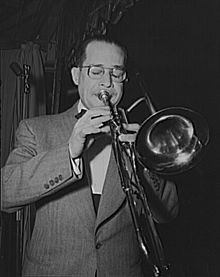Caravan (Jazz standard)
Caravan is a jazz standard composed by Juan Tizol and Duke Ellington . It was first recorded in 1936 by Barney Bigard , and in 1937 by the Duke Ellington Orchestra . The author's rights to the text are owned by Irving Mills .
The title
The first version of the title was recorded on December 19, 1936 by Barney Bigard And His Jazzopators in Hollywood . Between 1934 and 1938 many titles in the Ellington Orchestra's repertoire were written under the name of its musicians - Cootie Williams and Rex Stewart also recorded under their own names, and the line-ups were ultimately small band versions of the Ellington Orchestra; they were later released as The Duke's Men on LP / CD. In 1936 two takes were recorded, the first of which was released (Variety VA-515-1).
The performing musicians were Cootie Williams (trumpet), Juan Tizol (trombone), Barney Bigard (clarinet), Harry Carney (baritone saxophone), Duke Ellington (piano), Billy Taylor (bass) and Sonny Greer (drums). Ellington biographer Hans Ruland wrote about this recording: “Tizol introduces the topic here with its actually unjazzy phrasing . Cootie then takes on all the more thrilling, whereupon Carney does not let himself be ruffed with an amazingly flexible baritone saxophone and, as so often, leads Bigard farthest away from the topic so that Tizol finally finishes his caravan exactly as he started it. "
“The melody is emphatically chromatic, mysterious, almost oriental. Ellington arranged the song with additional orientalisms and gave it a new, more conventional middle section that contrasts rhythmically and tonally with the main melody. The piece draws its particular strength from this contrast. "
"Caravan" is considered one of the greatest hits Ellington ever had; the title became a permanent part of the band's repertoire. Written by Juan Tizol, however, Ellington developed the middle section and made it an "Ellington" title through the arrangement. Ellington biographer James Lincoln Collier comments on the recording by the Ellington Orchestra in 1937:
“ Tizol's melody is perfectly acceptable, but it's the arrangement that makes something out of the piece. In the first chorus , Duke supports the theme with a brief counter-statement repeated by the saxophones and adds a few growls from the trumpet to reinforce the eerie, exotic mood; he thereby reveals his ability to handle a number of voices simultaneously. As a result, the melody is "passed around" in the band in Ellington's style, first played by Barney Bigard, now by Cootie Williams with the plunger damper , then by a tenor saxophone. In any case, the solo part is supported by a subtle, inconspicuous opposing voice - the clarinet with a stuffed trumpet, the trumpet with the saxophone, etc. (...) It's a classic Ellington, full of changes, movement - but everything mixes like this easy that the listener hardly notices the parts because of the overall effect. "
Interpretations
The jazz song with its "exotic" sound reminiscent of the music of the Middle East has become a successful jazz standard and has been interpreted by countless musicians such as Art Blakey and his Jazz Messengers, Ella Fitzgerald , Dizzy Gillespie , Freddie Hubbard , Thelonious Monk , Art Pepper , Piero Umiliani , Oscar Peterson Lambert, Hendricks and Ross , Wes Montgomery , Angelo Debarre (with Ludovic Beier), Rabih Abou-Khalil , Chucho Valdés and Gonzalo Rubalcaba . He appeared as film music in two Woody Allen films, Alice and Sweet and Lowdown , as well as in the musical drama Whiplash by Damien Chazelle . He was also recorded by artists such as The Carpenters and the Mills Brothers . More recently, the rappers Redman and Busta Rhymes sampled it in their song "Da Goodness" (1998).
literature
- James Lincoln Collier: Duke Ellington . Berlin, Ullstein, 1999. ISBN 3-548-35839-X
- Hans Ruland: Duke Ellington . Oreos. Gauting. no year
Web links / sources
Individual evidence
- ↑ cit. after Ruland, p. 76
- ↑ Hans-Jürgen Schaal : SWR2 Jazztime: History of a Jazz Standard (Volume 15) (program booklet)
- ↑ cit. after Collier, p. 271

